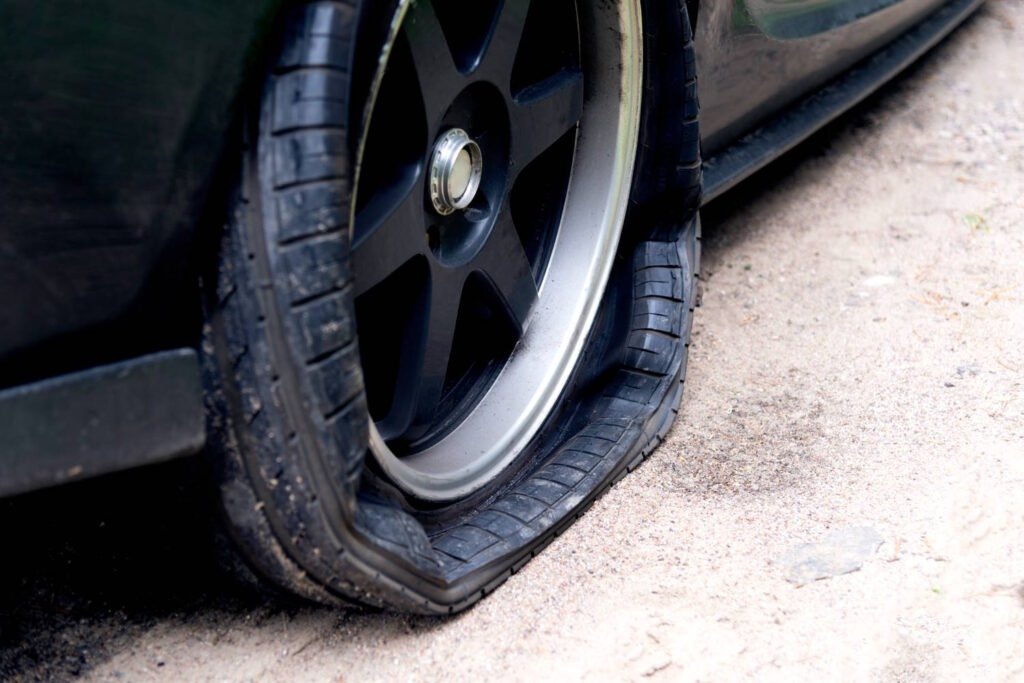Every driver will likely face a flat tire at some point. It’s a common issue, yet it can be a real source of stress if you’re unprepared. Knowing how to change a tire is not just a skill for mechanics or car enthusiasts; it’s something every driver can learn. Roadside assistance is helpful, but delays are common, especially during peak hours or in remote areas. Being able to change a tire on your own can save you from long waits and costly service charges.
In addition to convenience, changing a tire on your own gives you a sense of control and confidence behind the wheel. Think of it like knowing how to use a fire extinguisher. You hope you never need it, but when the moment comes, that knowledge can make all the difference.
What You Need in Your Trunk

Before trouble strikes, it’s smart to know what tools your vehicle carries and where they are. Most cars sold in the U.S. come with a basic toolkit for tire changes. This typically includes:
- A spare tire (either full-size or a temporary “donut”)
- A car jack to lift the vehicle
- A lug wrench for loosening and tightening the lug nuts
These are often tucked beneath a panel in your trunk or in a side compartment in SUVs. Ensure these tools are present and in good working condition. The spare tire should be fully inflated, or it won’t be much help when you’re stuck.
Additional helpful items include:

- Wheel chocks to prevent the car from rolling
- A flashlight in case you have to work in the dark
- Gloves to protect your hands
- A kneeling pad or a cardboard to cushion your knees
- A tire pressure gauge and portable inflator
- Reflective warning triangles or flares are especially useful at night or on highways
- A rain poncho and flathead screwdriver (for hubcap removal, if needed)
And don’t forget your car’s owner’s manual. It can tell you exactly where the jack points are and how to access your tire-changing tools.
Can you drive on a flat tire?
If you get a flat tire while driving, the first thing to do is remain calm and find a safe place to pull over. This could be a wide shoulder on a highway, a parking lot, or a side street. If you’re on a busy freeway, try to coast to an off-ramp or a rest area. Avoid sharp curves or hills where visibility is poor.
Once stopped, immediately turn on your hazard lights. They alert other drivers that your car is in distress. Then, set your parking brake. Even on flat roads, this keeps your car from rolling unexpectedly.
To stabilize your vehicle, place wheel chocks (or large rocks if you don’t have chocks) behind the tire diagonal to the flat one. For example, if your front passenger-side tire is flat, put the chocks behind the rear driver-side tire.

Getting Ready to Remove the Flat
Now it’s time to retrieve your tools and get to work. Remove the spare tire, jack, and lug wrench from your vehicle and lay them out within reach. If your flat tire has a hubcap or wheel cover, remove it first using the flat end of the lug wrench or a screwdriver. Pry around the edges gently until it pops off.
Before lifting the car, loosen the lug nuts while the wheel is still on the ground. This gives you the grip you need without the car wobbling. Turn each nut counterclockwise about a half-turn. If they are tight, you might have to step on the wrench to get them started, especially if they’ve been torqued by a power tool. Use a stable stance and brace yourself so you don’t lose balance.
If your vehicle has locking lug nuts, you’ll need the special key that usually comes with your car. It’s often stored with your spare or in the glove compartment. For nuts that won’t budge, try a penetrating lubricant like WD-40, or use a breaker bar or pipe extension for added leverage.

Raising the Vehicle Safely
Now that the lug nuts are loosened, it’s time to jack up the car. Every vehicle has specific jack points, reinforced areas along the frame designed to bear the vehicle’s weight during lifting. These are typically found just behind the front wheels and just in front of the rear wheels. Your owner’s manual will show you exactly where to place the jack. Never place the jack under the car’s floorboards, bumper, or suspension components, as doing so could damage your vehicle or lead to a collapse.
Position the jack under the correct point and start turning the handle or crank. Raise the car until the flat tire is about six inches off the ground. That should give you enough room to remove the damaged tire and install the spare. As a golden rule, never place your hands, feet, or any part of your body under the car while it is supported only by the jack.

Removing the Flat Tire
With the car elevated, fully remove the loosened lug nuts. Unscrew them one by one and keep them in a safe spot, like in the upturned hubcap or even in your pocket. You don’t want to lose them in tall grass or a storm drain.
Next, grip the flat tire by the treads and gently pull it straight toward you. It may feel heavy because many tires weigh between 20 and 30 pounds, and even more for larger vehicles like SUVs and trucks. Once removed, set it aside flat on the ground so it doesn’t roll away.

Installing the Spare Tire
Take the spare tire and line it up with the wheel studs, which are the threaded metal posts sticking out of the wheel hub. Align the holes in the spare with the studs, then push the tire firmly onto the hub until it sits flush.
Now it’s time to reattach the lug nuts. Screw them on by hand, turning clockwise, and tighten each one until it’s snug. At this stage, you don’t want to fully tighten them yet. Just tighten them enough to hold the spare securely in place.
To ensure even pressure, use a star pattern for tightening: tighten one nut, then move to the one directly across from it, and repeat. This technique prevents the wheel from going crooked.

Lowering and Final Tightening
Once the lug nuts are snug, lower the vehicle slowly by turning the jack handle in reverse. Bring the car down until the spare tire is touching the ground and is supporting the car’s weight. Then remove the jack completely.
Now go back to the lug nuts and tighten them firmly using the same star pattern. This time, apply as much force as possible. You may even need to use your body weight to ensure they’re fully tightened. Loose lug nuts can cause the wheel to wobble and eventually fall off, which is extremely dangerous. Some experts recommend using a torque wrench to match your car manufacturer’s specific lug nut torque specs, which are usually listed in your owner’s manual or on a sticker inside the driver’s side door.
If the spare tire came with a matching hubcap, reinstall it. If not, store the hubcap with the damaged tire in your trunk. Make sure to collect all tools, including the jack, wrench, and wheel chocks, and stow them securely.
How long can you drive on a spare tire
After successfully installing the spare tire, it’s tempting to breathe a sigh of relief and drive off as usual, but hold on. If you’re using a temporary spare, often called a “donut,” you’ll need to follow specific limitations. These smaller tires are intended for short-term, emergency use only.
Most temporary spares found in U.S. vehicles are rated for speeds of up to 50 miles per hour and distances of 50 to 70 miles. Their shallow tread and narrow profile provide less traction, which can affect your car’s handling and braking performance. It’s similar to wearing a dress shoe on one foot and a running shoe on the other—you’re technically mobile, but it’s not ideal.
If your spare is a full-size tire and it matches your other tires in both size and tread pattern, you may be able to drive more normally. However, even with a full-size spare, it’s important to get your flat tire repaired or replaced quickly. Also, consider including the full-size spare in your regular tire rotation to keep tread wear consistent.
No Spare? Here Are Your Options
Some newer vehicles no longer include a spare tire as part of the standard equipment. Instead, they may come with a tire repair kit, which usually includes a sealant and a small air compressor. The sealant is injected through the valve stem and temporarily seals small punctures, allowing the tire to be reinflated and driven on for a short distance.
However, these kits only work for certain types of damage. They are not effective for sidewall punctures, large gashes, or complete blowouts. If the tire damage is too severe or you’re not confident in the repair, it’s better to call for professional help.
Some vehicles come with run-flat tires instead of spares. These are built with reinforced sidewalls that allow you to drive at reduced speeds for about 50 miles after a puncture. While they offer more convenience than waiting for a tow, they tend to be more expensive to replace and can give a rougher ride than standard tires.
When in doubt or if you’re in an unsafe location, contact roadside assistance. Most U.S. auto insurers offer 24/7 support, and organizations like AAA are trusted by millions to provide quick help with flat tires and other emergencies.
Spare Tire Maintenance
A spare tire is one of those things you don’t think about until you need it. Like a first aid kit or flashlight, it’s critical to maintain even when it’s out of sight.
To make sure it’s ready for use:
- Check its air pressure once a month. Temporary spares often need higher pressure, typically around 60 PSI.
- Look for signs of aging or wear. Cracks, bulges, or dry rot can make a spar unsafe.
- Confirm tread depth. Even if unused, old rubber degrades over time.
- Replace the spare tire every six to ten years, regardless of usage.
- If you have a full-size spare that matches your main tires, include it in your tire rotation schedule to promote even wear.
According to AAA, over 30 million drivers in the U.S. face roadside issues each year. A large portion of these incidents involve flat tires, and being unprepared can mean a long, stressful wait for help.
Final Thoughts
Changing a flat tire is a skill that can turn a stressful situation into a manageable task. With preparation and a little practice, it becomes less intimidating and much more empowering. You don’t need to be an expert in this, just someone who’s ready to act when the situation calls for it.
Always put your safety first. If conditions are unsafe or if you’re not confident in handling the change, calling for help is the best choice. But when the time is right and the tools are ready, changing your tire can give you the kind of confidence every driver deserves.
We hope you find this article helpful. Here are some more helpful articles about Removing Tree Sap and water spots from cars and fixing Honda CRV EX cabin Air Filter buffer noise.



